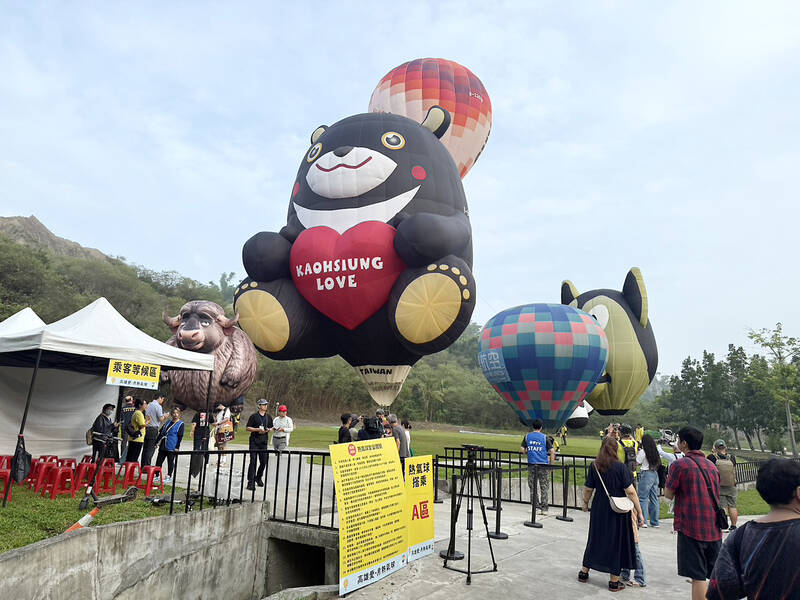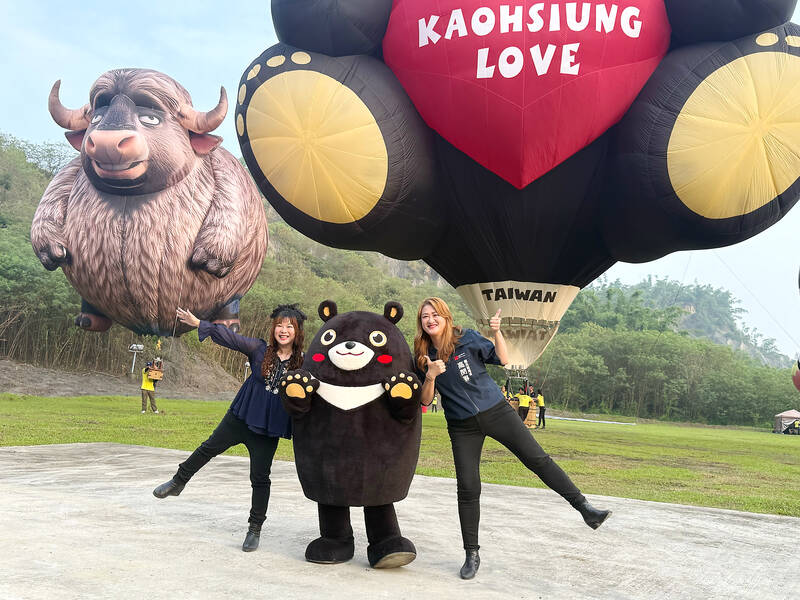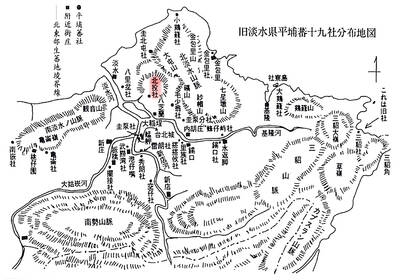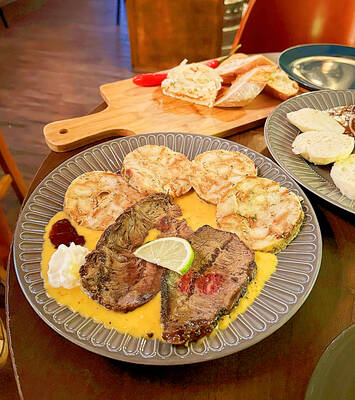One hour’s drive from Kaohsiung City, Tianliao Moon World geological scenic area sports impressive “mud hills” that look like a lunar landscape.
And for two weekends, this otherworldly place welcomes a hot air balloon festival.
“We initiated the yearly event in 2021,” says Lee Ya-Chu (李亞築), the city councilor representing the area, “to boost tourism after the pandemic.”

Photo: Julien Oeuillet
Half a dozen balloons gracefully hover up and down, with visitors waiting for their turn to board.
The largest balloon is shaped like the Kaohsiung Bear, an important symbol of the city.
“We had it built last year,” says Kao Min-lin (高閔琳), the director of tourism of Kaohsiung. “By Spanish company Ultramagic... We sent them a plushie of the bear to use as a model, and they liked it so much they asked to keep it.”

Photo: Julien Oeuillet
Now the bear brings people to the sky.
Evelyn Chen (陳怡伶), the team leader of the balloon operators, says finding the perfect launching place for the balloons involves reviewing all past climate data in a certain locale.
“Sometimes even in a good place with a good forecast, we may need to wait before we launch, and when we finally do, the audience cheers and that’s the best feeling,” Chen said.

Photo: Julien Oeuillet
LOVE RIVER
The mouth of the Love River is one of the very few coastal areas where the climate is appropriate for balloons, so the event will relocate there for its third and final weekend.
The flight itself grants a beautiful view of the area, suspended in mid-air in complete silence, save for the roaring of the stove when fire is pumped into the balloon. “It feels very hot,” says Kao, “you don’t need a hair dryer, just take your shower and jump in!”

Photo: Julien Oeuillet
The bear balloon also includes the word “Taiwan” written at the base.
“Normally there are no writings on balloons there,” says Kao, “but I insisted because we will send it around the world to other events. This year, for example, it will go to Thailand.”
The balloon pilot, Alec Su (蘇祐霆), says, “I wanted to be a plane pilot but they hired me for balloons instead. And I love sharing people’s stories while on board, I feel like I’m part of their journey.”

Seven hundred job applications. One interview. Marco Mascaro arrived in Taiwan last year with a PhD in engineering physics and years of experience at a European research center. He thought his Gold Card would guarantee him a foothold in Taiwan’s job market. “It’s marketed as if Taiwan really needs you,” the 33-year-old Italian says. “The reality is that companies here don’t really need us.” The Employment Gold Card was designed to fix Taiwan’s labor shortage by offering foreign professionals a combined resident visa and open work permit valid for three years. But for many, like Mascaro, the welcome mat ends at the door. A

The Western media once again enthusiastically forwarded Beijing’s talking points on Japanese Prime Minister Sanae Takaichi’s comment two weeks ago that an attack by the People’s Republic of China (PRC) on Taiwan was an existential threat to Japan and would trigger Japanese military intervention in defense of Taiwan. The predictable reach for clickbait meant that a string of teachable moments was lost, “like tears in the rain.” Again. The Economist led the way, assigning the blame to the victim. “Takaichi Sanae was bound to rile China sooner rather than later,” the magazine asserted. It then explained: “Japan’s new prime minister is

NOV. 24 to NOV. 30 It wasn’t famine, disaster or war that drove the people of Soansai to flee their homeland, but a blanket-stealing demon. At least that’s how Poan Yu-pie (潘有秘), a resident of the Indigenous settlement of Kipatauw in what is today Taipei’s Beitou District (北投), told it to Japanese anthropologist Kanori Ino in 1897. Unable to sleep out of fear, the villagers built a raft large enough to fit everyone and set sail. They drifted for days before arriving at what is now Shenao Port (深奧) on Taiwan’s north coast,

Divadlo feels like your warm neighborhood slice of home — even if you’ve only ever spent a few days in Prague, like myself. A projector is screening retro animations by Czech director Karel Zeman, the shelves are lined with books and vinyl, and the owner will sit with you to share stories over a glass of pear brandy. The food is also fantastic, not just a new cultural experience but filled with nostalgia, recipes from home and laden with soul-warming carbs, perfect as the weather turns chilly. A Prague native, Kaio Picha has been in Taipei for 13 years and